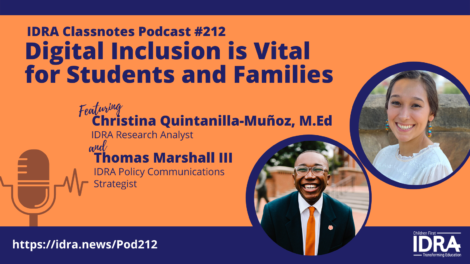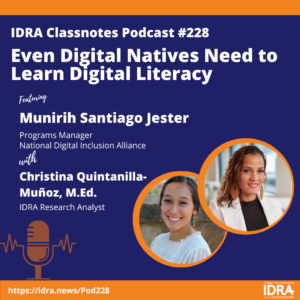This chapter focuses on advancing digital equity with data by providing a comprehensive overview on the topics of digital redlining, the disproportionate access of broadband Internet and digital technologies for historically marginalized communities in the U.S. South, and community-led solutions for bridging the digital divide. This is Chapter 4 of the IDRA Digital Equity – Online Technical Assistance Toolkit.
Module 1: Historical Redlining and Its Impact on Modern Access to Digital Technologies
This video is part of IDRA Digital Equity Online Technical Assistance Package. Chapter 4 focuses on advancing digital equity with data.
Digital redlining is the practice of income-based discrimination by Internet-service providers and other corporations who systematically exclude families in low-income neighborhoods from connecting to robust broadband Internet services.
Digital redlining perpetuates inequities within racially marginalized groups, specifically through the use of digital technologies, digital content, and the Internet. In this webinar, we discuss how digital redlining widens the digital divide and how the “homework gap” impacts students and their families. We also highlight digital literacy’s role in helping students and their families navigate digital technologies and online information.
This webinar features: Michelle Vega, IDRA chief technology officer Christina Quintanilla-Muñoz, IDRA research analyst, and Thomas Marshall, IDRA policy communications strategist and is the first module as part of the Data and Digital Redling chapter of the IDRA EAC-South Digital Equity technical assistance package.
Hear our work on digital equity at IDRA, provide a history of digital redlining and its disproportionate impact on Black and Latinx communities, and discuss forward-facing solutions to address the digital divide.
In the Red: Drawing the Line on Digital Redlining Practices – Webinar
Module 2: Assessing Disproportionate Access Across the U.S. South
This video is part of IDRA Digital Equity Online Technical Assistance Package. Chapter 4 focuses on advancing digital equity with data.
The current data map presents data from the 2021 American Community Survey (ACS) by the U.S. Census Bureau on: (a) household broadband subscription, (b) household computer access, (c) median household income, and (d) educational attainment for the 12 states, including the Commonwealth of Virginia, and the District of Columbia in the IDRA EAC-South, Region II. Additionally, this map indicates for each state/territory the name of their respective state broadband office, whether there is a state broadband plan available, and their digital opportunity gap score as assessed by the National Digital Inclusion Alliance (NDIA) State Digital Equity Scorecard.
Who Has Access
Digital redlining represents the evolution of discriminatory underinvestment in lower-income communities and communities of color in the digital age. Digital redlining refers to the neglect of investment in robust broadband infrastructure and delivery of quality, affordable Internet services by commercial Internet service providers (ISPs) in traditionally low-income residential areas (Popiel & Pickard, 2022).
Like its predecessor, digital redlining disproportionately impacts communities of color and communities of lower income and results in ISPs offering sub-standard Internet service plans of lower speeds at less affordable costs compared to those offered in more affluent communities. According to recent survey research by the Pew Research Center, Black and Latino adults in the U.S. are less likely than white adults to have access to home broadband; 80% of white adults reported having a broadband connection at home compared to 71% Black adults and 65% Latino adults in 2021 (Atske & Perrin, 2022). In digitally redlined areas, residents are deprived of basic access to quality broadband connections necessary for education, work, health, and entertainment.
How Access to Broadband is Measured
According to the Benton Institute for Broadband and Society, measuring communities’ access to broadband can be both challenging and incomprehensive due to the various ways access to broadband is measured (Horrigan, 2019). From network deployment, and network speeds to the adoption of broadband Internet, there are various challenges to measuring community access.
While policymakers consider various data when assessing need and determining investments, this data walk examines household broadband adoption (household subscription to broadband) as an indicator of the household’s access to the Internet.
In 2013, the ACS began the collection of data related to home Internet use and type of collection by including the following questions on the survey:
- “At the house, apartment, or mobile home do you or any member of this household have access to the Internet?” and
- “At this house, apartment or mobile home do you or any member of this household own or use any of the following types of computer?”
As previously mentioned, this data walk explores access to broadband across the U.S. South region by examining 2019 1-year ACS estimates of (a) household broadband subscription and (b) household presence of a computer by county for Alabama, Arkansas, the District of Columbia, Florida, Georgia, Louisiana, Mississippi, North Carolina, Tennessee, Texas, South Carolina, and Virginia.
Important Indicators of Access
In 2021, the U.S. Department of Commerce’s National Telecommunications and Information Administration (NTIA) released the publicly available Indicators of Broadband Need resource map. This map is an interactive tool that enables users to visualize and explore various data on broadband availability, access, and usage within the United States. Using public and private data, the tool highlights where broadband needs are greatest (NTIA, 2021).
While data such as presented in the NTIA broadband need map, decision-makers must consider other critical information when assessing need. Issues such as gaps in affordability of services offered by ISPs, trends of digital discrimination revealed by ISP investment maps, and certain residents’ limited access to affordable and reliable devices and digital skills training or support all contribute to the understanding of access to broadband Internet and online information.
Module 3: Bridging the Divide with Community Solutions
This video is part of the IDRA Digital Equity Online Technical Assistance Package. Chapter 4 focuses on advancing digital equity with data.
Digital Divide: Connectivity, Infrastructure and Devices – Webinar
Get practical solutions to addressing the digital divide for your students. This webinar explores immediate and sustainable long-term strategies that preserve the integrity of district fiscal policies. Presenters include Jordana Barton, MPA, Rene Gonzalez, Terrence Willson, J.D., and Michelle Martínez Vega.
IDRA Classnotes Podcast Episodes on Digital Equity
Listen to these podcast episodes as Michelle Vega, IDRA chief technology strategist, Thomas Marshall III, IDRA policy communications strategist, and Christina Quintanilla-Muñoz, IDRA research analyst discuss with regional partners the critical issue of digital equity and the work some Texas advocates are leading to ensure residents can secure affordable, dependable Internet connection.
These conversations highlight lessons learned and best practices from advocates in Texas who share insight on how their efforts to promote digital equity in their communities contribute to the tapestry of the digital justice movement. We will post additional episodes soon.
 Digital Inclusion is Vital for Students and Families – Podcast Episode 212 – The digital divide affects millions of Texas households that cannot get broadband Internet access. When schools moved instruction online due to the COVID-19 pandemic, this country’s simmering digital divide reached a boiling point. Millions of students were unable to access schoolwork or their teachers. In this episode, Christina Quintanilla-Muñoz, M.Ed., IDRA research analyst, and Thomas Marshall III, IDRA policy communications strategist, discuss the issue of digital inclusion and their work as IDRA Education Policy Fellows to advocate broadband access during the Texas Legislative session. They also highlight other advocates and organizations who partnered to secure affordable, dependable Internet connections for families. Christina and Thomas were interviewed by Michelle Martínez Vega, IDRA chief technology strategist.
Digital Inclusion is Vital for Students and Families – Podcast Episode 212 – The digital divide affects millions of Texas households that cannot get broadband Internet access. When schools moved instruction online due to the COVID-19 pandemic, this country’s simmering digital divide reached a boiling point. Millions of students were unable to access schoolwork or their teachers. In this episode, Christina Quintanilla-Muñoz, M.Ed., IDRA research analyst, and Thomas Marshall III, IDRA policy communications strategist, discuss the issue of digital inclusion and their work as IDRA Education Policy Fellows to advocate broadband access during the Texas Legislative session. They also highlight other advocates and organizations who partnered to secure affordable, dependable Internet connections for families. Christina and Thomas were interviewed by Michelle Martínez Vega, IDRA chief technology strategist.
 Even Digital Natives Need to Learn Digital Literacy – Podcast Episode 228 – Digital literacy is a critical skill for engaging in our world today. It is much broader than knowing how to operate a computer or navigate a website. Christina Quintanilla-Muñoz, M.Ed., talks with Munirih Santiago Jester of the National Digital Inclusion Alliance about what it means to be a digital inclusive society that fosters innovation. Munirih cautions use of the term “digital native” for describing young people today can lead to the belief that we don’t need to teach them anything about using technology appropriately or being good digital citizens. Christina Quintanilla-Muñoz, M.Ed., is IDRA’s research analyst and a former IDRA education policy fellow. Munirih Santiago Jester is programs manager for the National Digital Inclusion Alliance.
Even Digital Natives Need to Learn Digital Literacy – Podcast Episode 228 – Digital literacy is a critical skill for engaging in our world today. It is much broader than knowing how to operate a computer or navigate a website. Christina Quintanilla-Muñoz, M.Ed., talks with Munirih Santiago Jester of the National Digital Inclusion Alliance about what it means to be a digital inclusive society that fosters innovation. Munirih cautions use of the term “digital native” for describing young people today can lead to the belief that we don’t need to teach them anything about using technology appropriately or being good digital citizens. Christina Quintanilla-Muñoz, M.Ed., is IDRA’s research analyst and a former IDRA education policy fellow. Munirih Santiago Jester is programs manager for the National Digital Inclusion Alliance.


